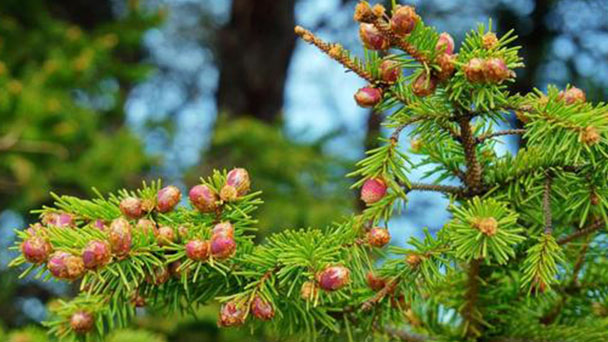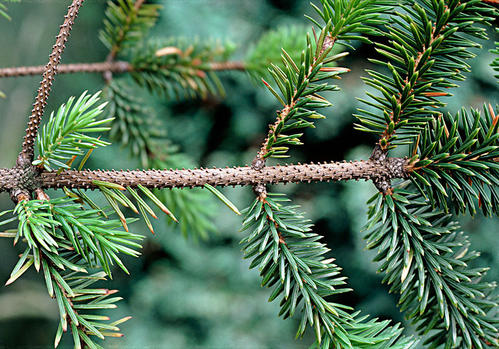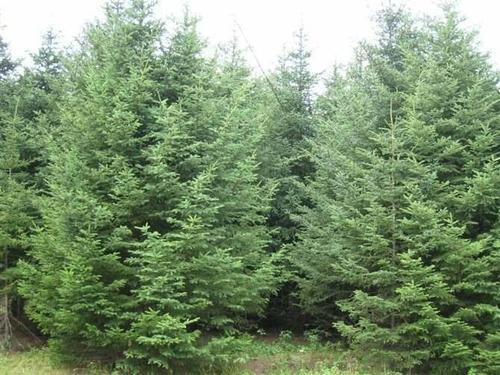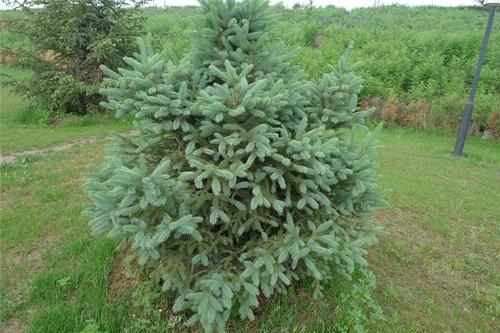Chinese spruce (dragon spruce) profile
Written by Maggie
Mar 22 2021

Chinese Spruce (Latin scientific name: Picea Asperata Mast.) is also called dragon spruce. For Chinese Spruce is up to 45 m high, diameter at breast height of 1 m; Bark is grayish brown or grayish brown, divided into irregular scales or somewhat thick patches falling off. Chinese spruce is a Chinese endemic species, native to southwestern Shaanxi).
Chinese spruce picture

Morphological characteristics of Chinese spruce
Branchlets of Chinese spruce are sparsely or densely pubescent, or glabrous, annual pale brown, brown, yellowish brown or reddish brown, leaves pillow with white powder, or white powder is not obvious, two or three years of life when grayish brown, brown or pale brown gray;Winter buds conical, resinous, base enlarged, apex of distal bud scales slightly or not inverted, apex of persistent bud scales at base of branchlets more or less inverted. Leaves of chinese spruce main branches are radiate, upper leaves of lateral branches extend upward, lower and lateral leaves curve upward, tetragonal, 1 -- 2 cm long, 1 -- 1.5 mm wide, slightly curved, apex slightly acute or acute, transverse section tetragonal, with stomata on all sides, 4 -- 8 on each upper side, 4 -- 6 on each lower side.
Cones terete of Chinese spruce is rectangular or cylindrical, tapering at upper end, green before maturity, pale brown or chestnut brown when ripe, 5 -- 16 cm long, 2.5 -- 3.5 cm in diameter; Middle species scales are obovate, ca. 2 cm long and ca. 1.5 cm wide, distally rounded or truncate closely arranged, or distally obtuse triangular loosely arranged, apex entire, or apex of cone base or middle lower species scales divided or slightly concave; Bract scales of Chinese spruce are triangular spatulate, ca. 5 mm long; Seeds are obovate, ca. 4 mm long, wings ca. 1.5 cm long, wings light brown, obovate-shaped rectangular; Chinese spruce has 6-7 cotyledons, tapered, 1.4-2 cm long, primary leaves tetragonal, 0.5-1.2 cm long, apex acute, with stomatal lines on all sides, entire or raised midvein with toothed hairs on the upper part.
Ecological Habits of Chinese spruce
Chinese Spruce is tolerant to shade and cold. It likes cool and humid climate and rich and deep, well drained slightly acidic sandy soil. It grows slowly and is a shallow-rooted tree species. Altitudes of 2400-3600 meters, often with Chinese Spruce, Minjiang Abies, Abies mixed, or pure forest.
Chinese Spruce is a shallow-rooted tree species, which is slightly tolerant to shade and can tolerate dry and cold environmental conditions. It grows rapidly and develops well in the slightly acidic brown forest land zone with cool and moist climate, deep soil layer and good drainage.In full light, a naturally regenerating forest thrives.
The distribution area of Chinese spruce
Chinese Spruce is endemic to China. It is widely distributed in the mountainous areas of North China and also in the Lesser Khingan Mountains in the Northeast. Chinese spruce is found in southwest shaanxi (fengxian), east Gansu (Liangdong), Bailong river basin, Tahoe river basin, upper minjiang river basin and small jinchuan basin in sichuan province.

Chinese spruce propagation methods
Chinese Spruce generally uses sowing or cutting to raise seedlings. It is best to cut 1-year-old full branches from 1-5 years old seedlings as cuttings, with the highest survival rate.Cuttage of hard branches in spring leaves after cutting, bundling, sand storage over the winter, the next spring into the seedbed, spray moisture, rooting 30 to 40 days. Twig cutting was carried out in spring. Semi-lignified branches were selected with a length of 12 to 15 cm, and rooting was done 20 to 25 days after insertion.
Chinese spruce seed grain is small, avoids drought and fear of waterlogging, should choose flat terrain, convenient drainage and irrigation, fertile, loose sandy loam for the garden. Sowing period with soil temperature above 12 degrees is appropriate, mostly in late spring. During seed germination and seedling stage, we should pay attention to frequent watering, keep the soil moist, and shade appropriately.
Seedling transplantation, small seedlings to bring more soil, big seedlings to bring soil ball. Before planting to apply sufficient base fertilizer, after planting water to pour through. Keep the soil moist during the growing season. Two years after colonization, fertilization was performed once before germination in spring, once in early summer and once in autumn.At seedling stage, prune appropriately and erect with fine bamboo.
Plants of 30 years old can be fruiting, and plants of 40 to 60 years old enter the fruiting peak. The optimum temperature for germination was 12-20 ℃, and the germination rate was 8%-10% 10 ~ 15 days after sowing. The seedling height can reach more than 40 cm.
Chinese spruce uses
The economic value
Wood straight, easy cutting, no hidden defects. Chinese spruce can be used as poles, sleepers, construction, bridge materials; It can also be used to make Musical Instruments, gliders, etc., and is the raw material of paper. Chinese spruce needles with oil content of about 0.1 ~ 0.5% can extract aromatic oil. The bark contained 6.9 ~ 21.4% tannin and could be extracted. Trees dignified appearance, strong adaptability, strong wind resistance, smoke resistance, fine wood texture, strong quality, water resistance, for Bridges, furniture materials; Artificial cotton and cordage are made from stem and bark fibers. Leaves are used as a medicine. Chinese spruce is a good material, for aircraft, Musical Instruments and paper, rayon raw materials; The trunk takes turpentine.
Ornamental value
Potted Chinese spruce can be used as indoor ornamental species, used in solemn occasions, before and after Christmas in winter, more placed in hotels, hotels and some families as Christmas tree decoration.

Latest Updated
- Benefits of Bugleweed - 7 Science-backed Health Benefits
- Bugleweed Dangers & Side Effects - Is It Poisonous?
- How to Plant Evergreen Trees - What You Should Know
- When to Plant Evergreens - Grow Guide for Evergreen Trees
- 12 Wonderful Evergreen Shrubs for Your Garden
- 12 Popular Evergreen Plants with Pictures for Beginners
- When And How To Prune A Lilac Bush Like a Pro
- How to Grow & Care for Lilac Vine (Hardenbergia Violacea)
- Japanese Lilac Tree (Syringa Reticulata) Care & Propagation Guide
- Shumard Oak Pros and Cons - What to Know
Popular Articles
- Winter maintenance of Antirrhinum Majus
- How to Grow Terminalia Mantaly Tree
- How to Grow and Care for Crossostephium Chinense
- How to grow Antirrhinum Majus in spring
- Peristeria Elata (Dove Orchid) Profile: Info & Care Guide
- Underwatered Snake Plant (Sansevieria Trifasciata) - Signs And How To Fix
- How to Care for Brazilian Jasmine Plant (Mandevilla Sanderi)
- How to Grow & Care for Graptopetalum Purple Delight in Summer
- Rosa Chinensis (China Rose): Plant Growing & Care Tips
- How to Care for Baby Sun Rose (Aptenia Cordifolia)